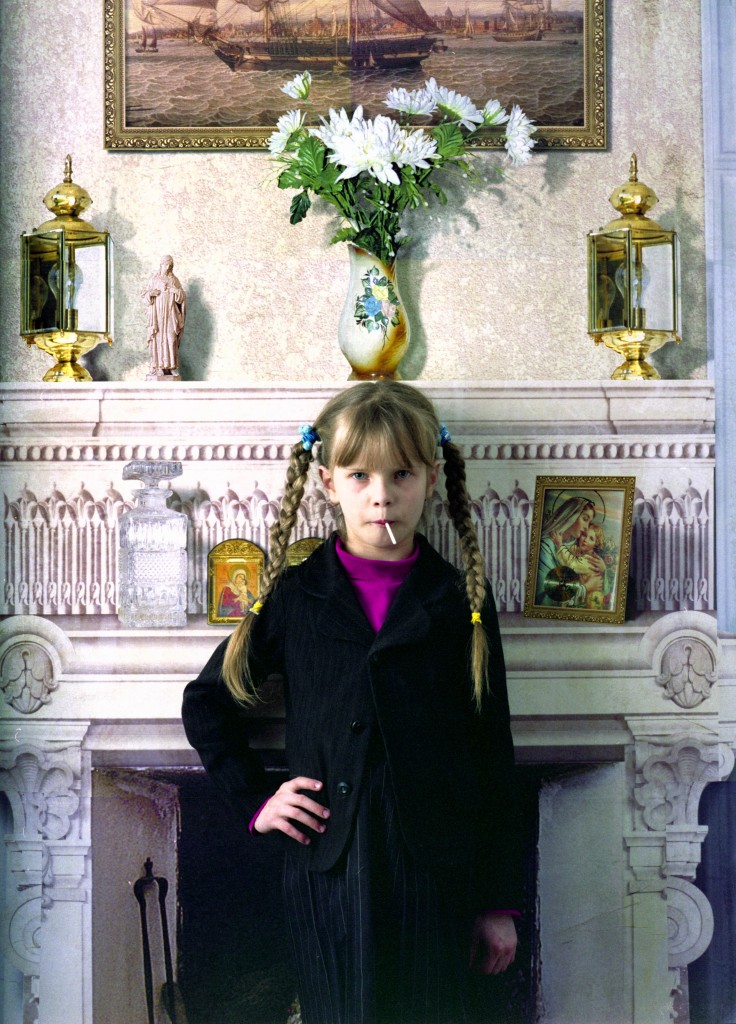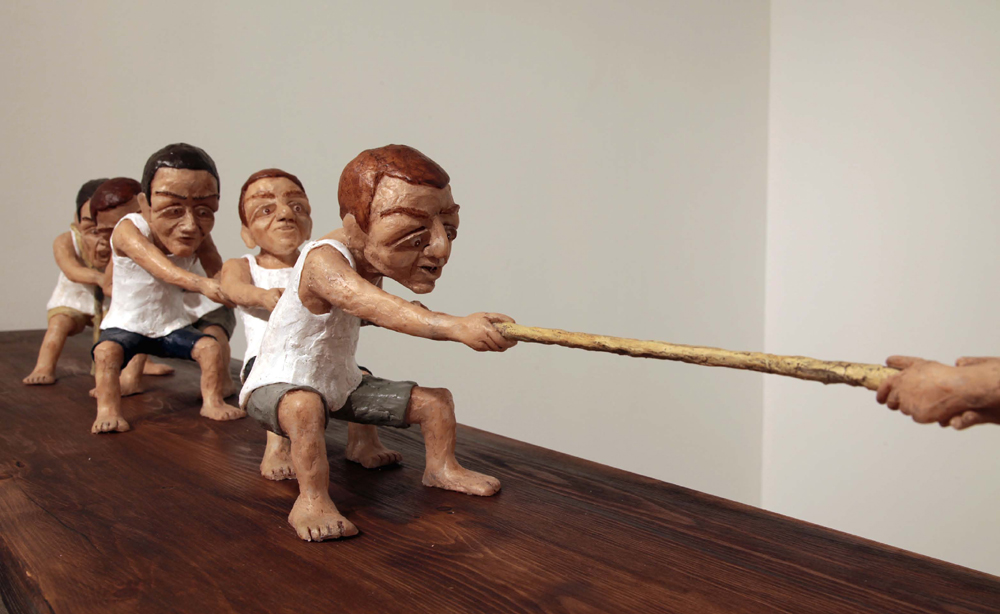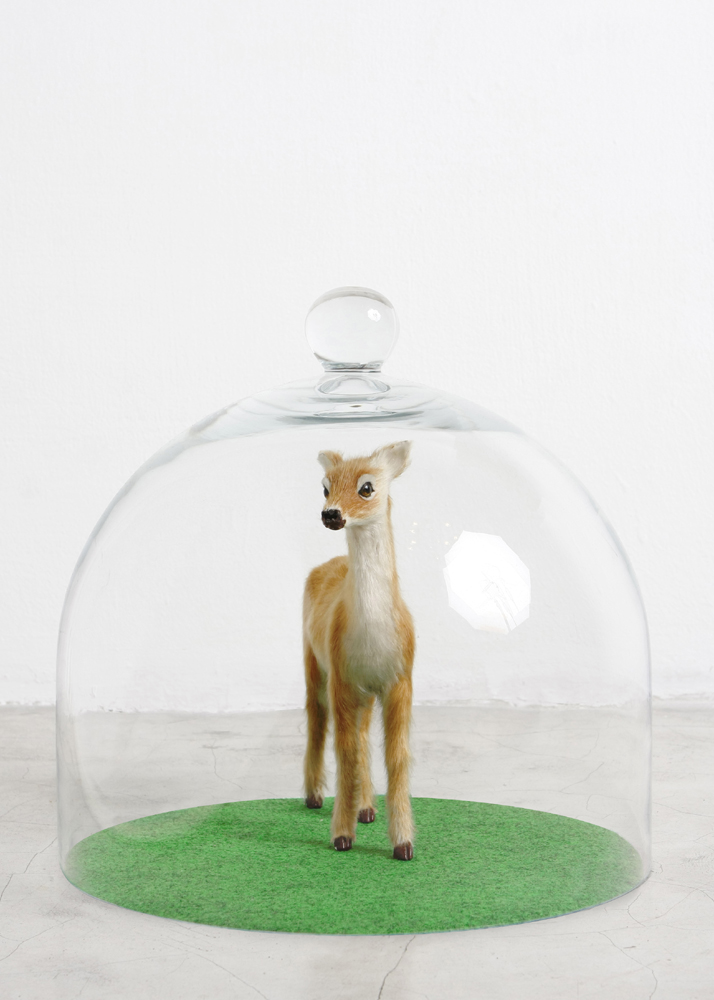
My first introduction to the four-day Art Fair Fresh Paint was at a preview for journalists when, climbing the outer stairway connecting the two floors of the exhibition, grey stains surfaced on my arm and new blue jeans. Apparently, minutes before, workmen had been coating the hand-rails with fresh layers of paint.
Indeed freshness, as regards both the site and the contents of this event, is an accurate description for the third reincarnation of this project. Last year the old Turkish train station adjoining Neve Tzedek, was indeed an appealing venue, but Warehouse 1, in Jaffa, port, proved to be an even more inviting and spacious location, with the added bonus of a spectacular view of the harbor and glistening blue sea.
As in previous years this event, founded by Sharon Tillinger Shafir, CEO, and Yifat Gurion, curator and art director, brought together gallery exhibitions and the display of works by independent artists, many at the start of their careers.
The Fair has at least two aims: the removal of the elitist aura surrounding contemporary art by making it more accessible to the general public; and a setting which gave exposure to younger artists and enabled them the opportunity to sell their work.
As in the two previous fairs, some praiseworthy community projects were featured. One of these was the Secret Postcard Exhibition (modeled on a similar event at London’s Royal College of Art) in which 1,500 post-card size original artworks were put up for sale for the price of 180 shekels each. Only after purchase, was the artist’s name revealed, and the buyer discovered whether he had purchased a work by a well known artist, or perhaps a rising star. Proceeds from this initiative went towards funding scholarships enabling talented youth from underprivileged backgrounds to study at the Arts Educational Center of Tel Aviv Museum.
Fresh Paint’s Video Greenhouse curated by Edna Moshenson, was a new and welcome feature of this year’s fair. Under the title Third Generation – Contemporary Video Works, 14 artists participated. Memorable was Avi Dabach’s video and sound piece Passing through Walls (7.30 mins). Taking his camera into the interior of an unidentified home, Dabach focused his camera on a table top where a collection of handsome ornaments were sited including a porcelain music box decorated with a pair of gyrating dancers. Above the table, a framed picture hung on the wall. At first tinkling music was heard, but then it was drowned out by the sound of a bulldozer growing louder and louder. A hole, ever widening, appeared in the wall. The picture tilted, the dancers disappeared, objects crashed to the ground. Falling stones and dust obscured one’s view, and when the air partially cleared, one saw only rock and debris. This video, one of only a handful of works in this show having a political agenda, was most effective in conveying a sense of tragedy and loss.
Allotted small spaces, twenty-eight of the country’s leading art galleries displayed representative works by the artists they promote. Among the many items that caught one’s eye was Gordon Gallery’s one-person exhibit – silhouettes of plants by Larry Abramson, one of the country’s best painters. This small gallery show was a tantalizing foretaste of the solo exhibition slated for Abramson this July at the Tel Aviv Museum.
Especially appealing for its ironical character was Televisions, an ironical offering by Zoya Cherkassky and German artist Avdey Ter-Oganian at the Rosenfeld Gallery created especially for this event. It consisted of 13 outdated TV cabinets displayed as though in a shop window. This piece made reference both to the commercial aspect of this art fair, and to the snobbish categorization of works of art. The TV sets and the cheap ornaments perched on top of them signified ‘low’ art and kitsch respectively; while ‘high’ art was represented by the paintings with which Cherkassky and partner had covered the TV screens. The images chosen also conjured up the past: a ball game in black and white; a clown from a long ago children’s program.

Among the galleries opened in recent years, some intriguing pieces were also noted. For instance, at RAWart, Carmel Ilan displayed attractive multi-layered landscapes of forests built up from papers torn from magazines; while at Hezi Cohen, Noga Shtainer showed some memorable images from her Home for Special Children, a photo series taken in a Ukrainian orphanage. Her depiction of Marika, a little girl with a lollipop in her mouth leaning against a mantelshelf displaying ornaments and religious artifacts was especially interesting due to the fact that it referred to a life and culture quite alien to our own.
Fifty-five independent artists were selected by a jury to participate in this year’s fair. They showed their work in small groups, each having a unifying theme. For instance, Booth 10 brought together artworks having connections to architecture. Among them were a number of impressive pieces by Nivi Alroy (b. Israel 1978, a graduate of Bezalel, and the School of Visual Arts, NYC.) Alroy has been awarded Fresh Paint’s 2010 prize for the fair’s Most Promising Artist Prize, given annually by art collector Igal Ahouvi. Aside from a cash prize of NIS 20,000, she will also get a solo show at next year’s event.
![Alroy03[1]](http://www.midnighteast.com/mag/wp-content/uploads/2010/05/Alroy031.jpg)
Alroy is an artist of unusual imagination and ability. Her wood carvings and small constructions built up of patterns derived from units of housing illustrate a concept in molecular biology: that single cells starved of food transform themselves into multi-cellular communities, thereby increasing their chances of survival. In her larger works, like Bulldog where the body of an animal is frozen in the act of intruding on a private space, Alroy explores the concept of outside threats to human domesticity.
In the same exhibition space Tal Amitai employed black thread sewn onto a Plexiglas’s surface to create a set of four delicate drawings. Based on photos of New Orleans homes destroyed in 2005 by the hurricane Katrina, they show houses which have become hollow shells, modern-day Vanitas images referring to the impermanence of life and material possessions. One of these drawings was selected at the start of the fair by Sotheby’s experts for their Under the Hammer award. It is to be included in Sotheby’s next Israeli and International Art sale, to be held in New York in December.
In general, the paintings on view this year made an indifferent impression; three-dimensional works whether installations or sculpture made a far stronger showing.

Of special note was the sculptural work of Shira Zelwer, winner of the Fair’s Most Promising Artist award in 2008. This year she showed doll-like figures fashioned from wax engaged in a tug of war. This piece, whose mirthless character recalled works by contemporary Chinese artists, is associated with childhood games, but also, with endless to- and-fro struggles on the political arena.
Among a group of works featuring Nature or animals, Hila Amram’s ‘Cabinet of Curiosities,’ made a lasting impression. Exploring connections between science and art, she showed wall works of insects and birds as well as small renderings of animals, some covered by bell jars.

Photography was also well represented. From the camera of Rubi Leibovitch came two fine lamda prints featuring a block of butter; the first in its pristine form, the second in its melted state. But he also showed an unpleasant work recalling Damien Hirst’s black ‘painting’ Judgment Day, composed of thousands of dead, resin-colored flies, In Leibovitch’s version a photo of insects became the background for a concentration of black plastic flies secured under glass.
Fresh Paint 3, has notched up another success. A quality event, it succeeded, in addition to its other aims, in giving an unprecedented overview of contemporary Israeli art. It is to be hoped that next year, additional sponsorship might enable the event to be kept open for a longer period enabling even more visitors to appreciate the vitality and diversity of our artists.
Fresh Paint 3 took place between May 5-8, 2010.
ANGELA LEVINE





